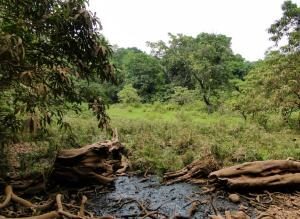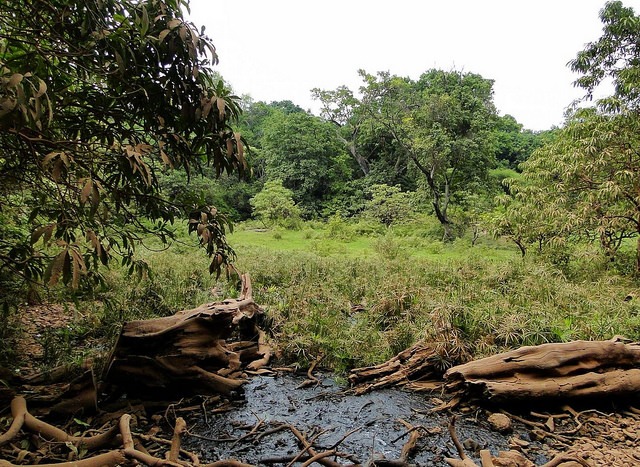
RUTGERS UNIVERSITY—About 1 to 2 million years ago, early humans in East Africa periodically faced very dry conditions, with little or no water in sight. But they likely had access to hundreds of springs that lingered despite long dry spells, allowing our ancestors to head north and out of Africa, according to a groundbreaking study by scientists at Rutgers University-New Brunswick and other institutions.
The international team showed that climate may not play such a primary role in human evolution as is commonly asserted.
“This has very important implications for human evolution,” said Gail M. Ashley, a professor in the Department of Earth and Planetary Sciences at Rutgers. “We’re not saying anything about why early humans left Africa. We’re only saying it was possible to leave Africa by going from one spring to the next and they could travel during dry periods.”
The study, which focuses on the key role of “hydro-refugia,” or water refuges, in East African hominin (early human) evolution and dispersal, was published today in the online journal Nature Communications. Hydro-refugia, a new term coined by the scientists, include springs, wetlands, groundwater-fed perennial streams and groundwater-fed rivers.
The study has global relevance since drylands cover about 45 percent of the Earth’s land mass. The importance of groundwater for the survival of our hominin ancestors during dramatic climate swings could inspire and inform strategies for human resilience to future climate change, the study says.
For several million years, the African climate has fluctuated between wet and dry in 23,000-year cycles. And since most lakes are undrinkable (saline or alkaline) and rivers dry up for large parts of the year in East Africa, where early humans arose, the study focused on the viability of groundwater-fed springs.
Rainwater is stored in large underground aquifers and moves slowly until it seeps out onto the surface as springs. The location of groundwater-fed springs is controlled by geology and the groundwater supply is buffered against climate change, according to Ashley, a geologist whose curiosity about springs prompted the study.
The study area is vast – nearly 2.1 million square kilometers (some 808,000 square miles), stretching from northern Tanzania to Ethiopia and focusing on the East African Rift Valley. And the scientists performed hydrogeological modeling of the current landscape. A spring that discharges 1,000 cubic meters of water (about 264,000 gallons) a year was deemed productive enough to maintain continuous flow.
“I’m absolutely amazed how in some places, it looks like a trickle of water is coming out and yet it will supply hundreds of animals a day,” said Ashley, who has conducted research in the region since 1994 and has studied many springs.
Using today’s distribution of lakes, rivers and springs sprinkled along the valley from northern Tanzania to Ethiopia, a computer study was performed to see if it would have been possible for humans to walk from one water source to another and survive. The study assumed that a person could walk up to 180 kilometers, or about 112 miles, in three days.
“In some places, people could not migrate and they would have stayed at one spring for quite a long time until it got wetter again, and then more springs would open up and they could continue to move,” Ashley said.
People have always assumed that climate was the main factor in human migration and human evolution, she said.
“Climate fluctuated, but the geology allowed the development and maintenance of springs – hydro-refugia – on the landscape, allowing humans to disperse and migrate out of Africa,” she said. “The bigger question is what motivated humans to move up the East African Rift Valley. We know they did and we have shown how it was possible, but we don’t really have a logical reason for them doing that.”
_______________________________________
A spring in Lake Manyara National Park in northern Tanzania, just south of Olduvai Gorge. Credit: Gail M. Ashley, Rutgers University
___________________________________________________
Article Source: Rutgers University news release
____________________________________________________
Subscribe to Popular Archaeology Premium. Available on all laptops and mobile devices, and still the industry’s best value at only $9.00 annually.
___________________________________________
Travel and learn with Far Horizons.
____________________________________________
This richly illustrated issue includes the following stories: Recent findings shedding new light on the whereabouts of the remains of Philip of Macedon, father of Alexander the Great; how an archaeologist-sculptor is bringing bones of the dead back to life; archaeologists uncovering town life at the dawn of civilization; an exclusive interview with internationally acclaimed archaeologist James M. Adovasio about what makes the Meadowcroft Rockshelter prominent in the ongoing search for the first Americans; what archaeologists are finding at the site of the ancient city of Gath, the home town of the biblical Philistine giant, Goliath; and how scientists are redrawing the picture of human evolution in Europe. Find it on Amazon.com.





